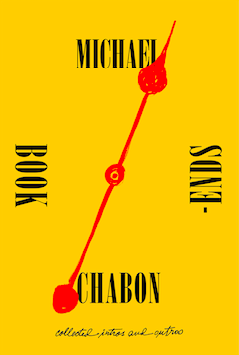
In Bookends, his new collection of forewords, afterwords, prefaces and liner notes, Michael Chabon (The Amazing Adventures of Kavalier & Clay) promises to perform criticism—though he rather studiously eschews the term. “There are many reasons a writer might agree to provide an introduction to her own or another writer’s book,” he writes: “affection, gratitude, regret, revenge, enthusiasm, a desire to evangelize or set the record straight.”
The reasons Chabon enumerates here are the arrows in a critic’s quiver, and if the nature of publishing means “revenge” gets short shrift, Bookends nonetheless demonstrates a critical cast of mind. In pop culture, “critic” most often connotes a person blinded by sneering distaste, becoming a synonym for “snob” (see Lindsay Duncan’s theatre critic in Birdman, or Ratatouille’s Anton Ego). But the critic’s task, after the term’s Greek root, krinein, is “to judge”—or, better yet, “to decide.” Chabon’s choices, as both reader and writer, lend Bookends its shape—from the texts he’s selected to introduce to the form in which he does it. From this, one might glean a richer understanding not only of what the critic does, but also of how.

 1. Read widely. Read Raymond Chandler and Robert Towne, Norse myths, enough comic strips to know Howard Chaykin from Ben Katchor. Read the classics of science fiction (Ray Bradbury, Edgar Rice Burroughs) and children’s literature (The Phantom Tollbooth) alongside lesser-known fictions by mentors (MacDonald Harris) and friends (the late Amanda Davis). Read scholarship on superheroes, treatises on tricksters, obscure Swedish novels from the Second World War. Read pop music, soul food, your own shelved novel. In this morass, you may find answers to questions you didn’t ask, pleasures you hadn’t sought, convictions you weren’t aware you needed.
1. Read widely. Read Raymond Chandler and Robert Towne, Norse myths, enough comic strips to know Howard Chaykin from Ben Katchor. Read the classics of science fiction (Ray Bradbury, Edgar Rice Burroughs) and children’s literature (The Phantom Tollbooth) alongside lesser-known fictions by mentors (MacDonald Harris) and friends (the late Amanda Davis). Read scholarship on superheroes, treatises on tricksters, obscure Swedish novels from the Second World War. Read pop music, soul food, your own shelved novel. In this morass, you may find answers to questions you didn’t ask, pleasures you hadn’t sought, convictions you weren’t aware you needed.
2. Locate the unfamiliar. Even if your chosen subject is more popular than, say, The Sailor on the Seas of Fate, you must still seek out its mysteries: the meaning more complicated than it seems at first blush; the unexpected feeling that stirs in your stomach; the biographical detail or ideological subtext that, on closer examination, becomes the key characteristic, the argument’s crux. Without the unfamiliar, you are bound to offer no more than a pale rehearsal of the original. With it, you have, as they say, made a contribution. You have alighted, for instance, on the heretofore elusive point of contact between Wes Anderson’s films and Joseph Cornell’s assemblages—that movies, too, are boxes, miniatures of the world beyond the frame, and that Anderson, like Cornell, simply makes the metaphor explicit. You have, after a fashion, illuminated the manuscript, and made mysteries its filigree.
3. Make the unfamiliar familiar. Once you have identified an artwork’s mysteries (note: in the finest of these they are infinite, or close to it), your task is to unravel them (note: I did not say “solve”), and it is in this demystification that the real work begins, with all its accompanying pitfalls. In explanation, elucidation, categorization, allusion you are most apt to lose your reader—a person, whatever his or her other qualifications, with a highly sensitive bullshit detector—and the fear of doing so opens the door to factual error, cliché, hyperbole, pandering, not to mention slapdash logic and even worse prose (note: this is the “hot take”). If you tread carefully, though, speaking frankly and in layperson’s terms about the topic at hand—about what it is, and more importantly how it is, and most importantly why that matters—then you might succeed in deconstructing for the comic book novice the superhero’s costume, removing its component parts item by item until it is a halftone-dot projection of one’s secret identity, “not who we are but the story of how we got that way.” This is the brass ring you are always reaching for and rarely touch: to transform the illuminated manuscript into an illuminated mind.
4. Generate enthusiasm. Held against this lofty goal, simply introducing your reader to a beloved artwork—particularly if it has been misunderstood, maligned, underappreciated or forgotten—may not merit the same degree of difficulty. But it is no less life-altering: If you’ve completed steps one through three (hell, if you’ve made it through reading about steps one through three), you’ve surely had a poem, a short story, a novel, a comic book, an album, a film, a TV series, a museum exhibition, a recipe for French onion soup pressed into your proverbial hands, only to discover that it is the skeleton key to other doors. You might have been urged to read “The Turn of the Screw,” for instance, down whose corridor you found first Balzac, Poe, de Maupassant, Kipling and then M.R. James’ “Oh, Whistle, and I’ll Come to You, My Lad,” “one of the finest short stories ever written.” This is where you pay it forward. Press the life-altering love potion of ghost stories or Monsterman or Michael Chabon into your reader’s hands, unstopper the vial, and say, “Drink.”
5. Maintain skepticism. Insincere enthusiasm is also called cant, and there is no better strategy for avoiding it than allowing for skepticism—even when that skepticism is aimed at an artwork you care for. This is where “judgment” supersedes “decision,” where discernment reigns; if you cannot fairly weigh an artist’s failure, noble or otherwise, you cannot be trusted to celebrate his or her success. At their logical extremes, the poseur performs affection for work he despises and the contrarian performs contempt for work he adores, both out of the desire to meet or defy an expectation of taste, rather than to grapple with it (note: this is not criticism.) At her logical extreme, the skeptic has no logical extreme; skepticism’s purpose is clarity, not extremity, its outcome precision, not excess. The skeptic can, for instance, differentiate the particular nostalgia of Julius Knipl: Real Estate Photographer from the generalized nostalgia of “animatronic replicas, politicians’ narratives, and the fictions of advertisers” by cutting the latter from the former as if it were a cancer. The skeptic is the enthusiast’s surgeon—the former’s scalpel keeps the latter alive.
6. Embrace the personal. Though it’s beaten out of you by college professors and newspaper editors, by your own posture of authority, the most important tool in your toolbox is the inescapable “I.” You necessarily experience works of art—new or old, familiar or unfamiliar, digestible or inexplicable—in the first person, and though the writing process may eradicate its markers, there’s no erasing your point of view. As long as your judgments, your decisions, remain in the realm of the five prior rules—and not driven by petty slights, unexamined thoughts, the thirst for attention—it’s fair to confess your feelings about art, and then to sift through them for meaning. Sometimes it’s as simple as admitting to a blind spot or bias (perhaps you will never not love a musical episode of a non-musical TV series). Sometimes it’s as thorny as confronting a version of yourself you’ve long ignored (perhaps you come to realize, years later, that your botched attempts to explain your baseball-themed “American faerie” were a way of avoiding the awful truth, which is that you wrote it after you and your wife decided to terminate a pregnancy). The conclusion you draw must still be about the art, the reader, and not just yourself—to wit: “Epic fantasy is the literature of our innate consciousness that we have inherited a world in ruins”—but being yourself may be the most direct route to that end. Sometimes the only way out is through.
7. Never apologize. This does not mean that you are above correction and counterargument, immune from logical missteps, muddy prose style or niggling second thoughts. Nor does it mean that you should pretend as though your past decisions are beyond reproach (note: they aren’t). It means, rather, that the questions raised, the enthusiasms cultivated, the skepticisms ventured, the emotions examined are yours and yours alone, and that mincing words about what you love, or hate, or remain ambivalent about is the surest way to lose touch with your craft. No one but you can defend your judgments, your decisions, and that defense can only be mounted if you came to your conclusions honestly. It’s for this that you needn’t ever apologize, and as such, following this rule—really following it, without bad-faith hand-waving and slipshod writing and constant backtracking and soul-devouring fear—is hardest of all. When it works, though, it is worth every impossible choice. “When it works,” as you may say of American Flagg!, “what you get is not a collection of references, quotes, allusions, and cribs but a whole, seamless thing, both familiar and new: a record of consciousness that was busy falling in love with those moments in the first place.”

Of course, these aren’t Chabon’s seven rules for writing the perfect introduction. If Bookends is any indication, there aren’t any hard-and-fast rules for writing at all; each one you might devise, per the introduction to the unpublished Fountain City, undercuts itself before you’ve finished devising it. Rather, they’re seven pieces of the jigsaw puzzle Chabon lays out—in more than two dozen forewords, prefaces, afterwords and liner notes penned over the course of more than two decades—labeled and ordered as I see fit.
Chabon may not describe this process as “criticism,” but I do—and I won’t apologize, either. Bookends is, ultimately, a collection of wide-ranging, envy-making, page-turning criticism: what it is, how it is and why it matters. Above all else, it’s an introduction to what criticism is for.
Bookends: Collected Intros and Outros by Michael Chabon is available now from Harper Perennial.